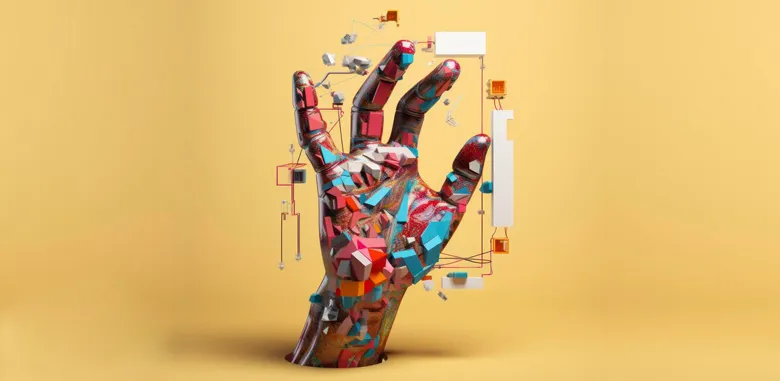
Fadoua Adib
Design Graphique, Marketing Digital
Comments Off on The Inexorable Rise of Artificial Intelligence in Graphic Design
Artificial intelligence (AI) has injected a wind of change into almost every aspect of our daily lives, and the world of graphic design is no exception. Over the years, AI has evolved by leaps and bounds, from a mere futuristic notion to a revolutionary creative engine. In this article, we take a deep dive into the rise of AI in graphic design and examine how it has reshaped the visual creativity industry.
Rethinking Creativity with AI Graphic designers are visionaries who embody the fusion of art and communication. The integration of AI into this field has sparked debate and questioning about the very nature of creativity. But instead of replacing human creativity, AI has reimagined it. Content generation algorithms have opened up new avenues of design, producing unique compositions that designers can use as the basis for even more innovative projects.
Inspired Visual Content Generation AI has the power to transform data into visual inspiration. By analyzing thousands of images, patterns and styles, algorithms can create intriguing graphic elements. Unexpected illustrations, bold color combinations and avant-garde designs are now within reach thanks to the collaboration between human creative minds and algorithmic ingenuity. The Effervescence of Personalization In a world where personalization has become the norm, AI has further strengthened this trend in graphic design. Through the collection and analysis of data on individual preferences, algorithms can design visuals that resonate deeply with each target audience. This paves the way for a more powerful and relevant visual communication, while also enhancing audience engagement.
A New Era of Image Retouching Image retouching has always been an essential part of graphic design, but AI has redefined the way it is approached. AI-assisted retouching tools can automatically identify areas for improvement, correct imperfections and enhance the overall quality of an image. This allows designers to spend less time on technical details and more time on artistic expression.
Harmonious collaboration AI and graphic designers are no longer simply separate entities, but rather collaborators. Designers use AI as a tool to expand their creativity and accelerate their workflow. AI, for its part, feeds on human expertise to refine its capabilities and produce more refined results.
The Future of AI in Graphic Design As we contemplate the horizon of AI in graphic design, one thing is certain: this relationship between man and machine will continue to evolve. Designers will become more adept at leveraging AI, and algorithms will continue to refine to meet the needs of the industry. AI could also pave the way for even more interactive and immersive designs, revolutionizing the way we interact with visuals. Ultimately, the rise of AI in graphic design embodies an intriguing symbiosis between human creativity and algorithmic computing power. The possibilities offered by this collaboration are only just beginning to emerge, and it’s up to designers to embrace these changes with enthusiasm and creativity, to shape a visual future that blends timeless art with futuristic innovation.
Rethinking Creativity with AI Graphic designers are visionaries who embody the fusion of art and communication. The integration of AI into this field has sparked debate and questioning about the very nature of creativity. But instead of replacing human creativity, AI has reimagined it. Content generation algorithms have opened up new avenues of design, producing unique compositions that designers can use as the basis for even more innovative projects.
Inspired Visual Content Generation AI has the power to transform data into visual inspiration. By analyzing thousands of images, patterns and styles, algorithms can create intriguing graphic elements. Unexpected illustrations, bold color combinations and avant-garde designs are now within reach thanks to the collaboration between human creative minds and algorithmic ingenuity. The Effervescence of Personalization In a world where personalization has become the norm, AI has further strengthened this trend in graphic design. Through the collection and analysis of data on individual preferences, algorithms can design visuals that resonate deeply with each target audience. This paves the way for a more powerful and relevant visual communication, while also enhancing audience engagement.
A New Era of Image Retouching Image retouching has always been an essential part of graphic design, but AI has redefined the way it is approached. AI-assisted retouching tools can automatically identify areas for improvement, correct imperfections and enhance the overall quality of an image. This allows designers to spend less time on technical details and more time on artistic expression.
Harmonious collaboration AI and graphic designers are no longer simply separate entities, but rather collaborators. Designers use AI as a tool to expand their creativity and accelerate their workflow. AI, for its part, feeds on human expertise to refine its capabilities and produce more refined results.
The Future of AI in Graphic Design As we contemplate the horizon of AI in graphic design, one thing is certain: this relationship between man and machine will continue to evolve. Designers will become more adept at leveraging AI, and algorithms will continue to refine to meet the needs of the industry. AI could also pave the way for even more interactive and immersive designs, revolutionizing the way we interact with visuals. Ultimately, the rise of AI in graphic design embodies an intriguing symbiosis between human creativity and algorithmic computing power. The possibilities offered by this collaboration are only just beginning to emerge, and it’s up to designers to embrace these changes with enthusiasm and creativity, to shape a visual future that blends timeless art with futuristic innovation.



